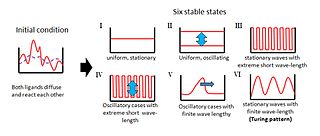Turing pattern
_




The concept of a Turing pattern (often referred to in the plural as Turing patterns) was introduced by the English mathematician Alan Turing in a 1952 paper entitled The Chemical Basis of Morphogenesis.[1] This foundational paper describes the way in which patterns in nature such as stripes and spots can arise naturally out of a homogeneous, uniform state.
The original theory, a reaction–diffusion theory of morphogenesis, has served as an important model in theoretical biology.[2] Reaction–diffusion systems have attracted much interest as a prototype model for pattern formation. Patterns such as fronts, hexagons, spirals, stripes and dissipative solitons are found in various types of reaction-diffusion systems, despite large discrepancies, in the local reaction terms for example.
As well as in biological organisms, Turing patterns occur in other natural systems – for example, the wind patterns formed in sand. Although Turing's ideas on morphogenesis and Turing patterns remained dormant for many years, they are now inspirational for much research in mathematical biology.[3]
See also
Bibliography
- Template:Cite article
- Template:Cite article
- Ball, Philip (31 May 2012). "Turing Patterns". Chemistry World. (See also extended version, June 2012.)
- Template:Cite article
- Campagna, R.; Cuomo, S.; Giannino, F.; Severino, G.; Toraldo, G. (6 December 2017). "A semi-automatic numerical algorithm for Turing patterns formation in a reaction-diffusion model". IEEE Access. 6: 4720–4724. doi:10.1109/ACCESS.2017.2780324.
- "New theory deepens understanding of Turing patterns in biology". Phys.org. European Molecular Biology Laboratory. 20 June 2018.
- Iber, Bagnar. "Turing Pattern" (PDF). Computational Biology (CoBI). Switzerland: ETH Zurich. Retrieved 16 August 2018.
References
- ^ Turing, A. M. (1952). "The Chemical Basis of Morphogenesis" (PDF). Philosophical Transactions of the Royal Society of London B. 237 (641): 37–72. Bibcode:1952RSPTB.237...37T. doi:10.1098/rstb.1952.0012. JSTOR 92463.
- ^ Harrison, L. G. (1993). Kinetic Theory of Living Pattern. Cambridge University Press.
- ^ Woolley, T. E., Baker, R. E. Maini, P. K., Chapter 34, Turing's theory of morphogenesis. In Copeland, B. Jack; Bowen, Jonathan P.; Wilson, Robin; Sprevak, Mark (2017). The Turing Guide. Oxford University Press. ISBN 978-0198747826.
{{cite book}}: Cite has empty unknown parameter:|1=(help)
